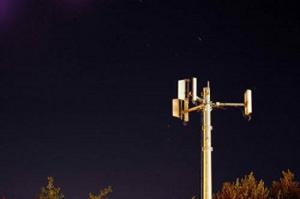Disaster communicationAT&T shows mobile cell towers for disaster communication
A new family of solutions from AT&T will make business, government, and public safety agencies better prepared for natural or man-made disasters; one of the new offerings, the “Fly-away” solution, packs a small cell site into a suitcase, offering first responders an easy-to-use, transportable system that can bring voice and data coverage to an area where disaster has knocked out communication channels

Portable cell tower deployed // Source: thejakartaherald.com
One of the first thing to go during a disaster is the communication system, making the work of first responders and search-and-rescue teams that much harder. This important emergency work will become easier with a new solution, just unveiled by AT@T. The solution will make business, government, and public safety agencies better prepared for natural or man-made disasters. The solution is AT&T Remote Mobility Zone, a new offering that provides mobile voice and data services in the absence of wireless coverage. A company release says that the solution is designed to support essential communications, allowing organizations to set up their own cell sites during a disaster. AT&T says it is the first carrier to supply a customer-deployable model for mobility recovery to help with disaster recovery and business continuity efforts.
“In the pivotal first minutes of a natural or man-made disaster, AT&T Remote Mobility Zone provides a solution to help maintain critical mobile communications,” said Chris Hill, vice president, Advanced Mobility Solutions, AT&T Business Solutions. “With AT&T Remote Mobility Zone, users can set up a cell site in less than 30 minutes.”
AT&T Remote Mobility Zone is also suited for organizations that operate in remote locations where AT&T holds licensed spectrum, but in which wireless coverage may not be available. AT&T Mobility Vanguard Services LLC, a wholly owned subsidiary of AT&T, can install permanent cell sites for customers that work in these areas, providing mobile voice and data service.
The company says it offers several options of Remote Mobility Zone solutions:
- Fixed site deployment establishes a mounted cell site for use as a backup communications system or as a primary network in zones without wireless network coverage. This can help business continuity and disaster recovery capabilities by enabling sensitive operations to proceed even in loss-of-service situations.
- The “Fly-away” solution packs a small cell site into a suitcase, offering first responders an easy-to-use, transportable system that can bring voice and data coverage to an area where disaster has knocked out communication channels. These small cell sites can extend connectivity up to one half of a mile in any direction from the suitcase site. Created for use by police officers, firefighters, and other emergency responders, the Fly-away AT&T Remote Mobility Zone option is currently available to government agencies and personnel.
- “Park and Use,” designed specifically for government use, integrates small cell sites into vehicles, allowing users to drive to locations without wireless coverage and activate service then and there. Roof-mounted satellite antennas further enhance communications on the move.
Customers that choose to protect their communications with AT&T Remote Mobility Zone can use their existing AT&T handsets with all three of the solutions listed above. Additionally, in disaster or emergency conditions, AT&T Remote Mobility Zone clients with AT&T Wireless Priority Service can choose to prioritize certain cellular traffic to ensure that key personnel can access the network.
The release notes that this latest solution is an addition to AT&T’s portfolio of solutions that offer companies and government business continuity services which address disaster planning, risk management, recovery preparedness, and communications readiness.
The company says it also conducts several Network Disaster Recovery (NDR) exercises each year, the most recent of which took place in Dallas in March. The company has invested more than $600 million in its NDR program, which includes specially trained managers, engineers, and technicians from across the United States, as well as a fleet of more than 320 self-contained equipment trailers and support vehicles that house the same equipment and components as an AT&T data-routing or voice-switching center.
